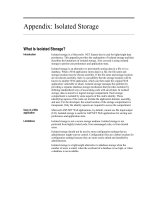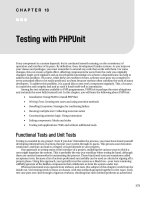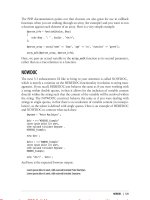Tài liệu PHP Team Development docx
Bạn đang xem bản rút gọn của tài liệu. Xem và tải ngay bản đầy đủ của tài liệu tại đây (2.03 MB, 183 trang )
PHP Team Development
Easy and effective team work using MVC, agile
development, source control, testing, bug tracking,
and more
Samisa Abeysinghe
BIRMINGHAM - MUMBAI
This material is copyright and is licensed for the sole use by David Martone on 16th September 2009
710 South Avenue West, , Westfield, , 07090
PHP Team Development
Copyright © 2009 Packt Publishing
All rights reserved. No part of this book may be reproduced, stored in a retrieval
system, or transmitted in any form or by any means, without the prior written
permission of the publisher, except in the case of brief quotations embedded in
critical articles or reviews.
Every effort has been made in the preparation of this book to ensure the accuracy
of the information presented. However, the information contained in this book is
sold without warranty, either express or implied. Neither the author, nor Packt
Publishing, and its dealers and distributors will be held liable for any damages
caused or alleged to be caused directly or indirectly by this book.
Packt Publishing has endeavored to provide trademark information about all of the
companies and products mentioned in this book by the appropriate use of capitals.
However, Packt Publishing cannot guarantee the accuracy of this information.
First published: September 2009
Production Reference: 1240809
Published by Packt Publishing Ltd.
32 Lincoln Road
Olton
Birmingham, B27 6PA, UK.
ISBN 978-1-847195-06-7
www.packtpub.com
Cover Image by Ed Maclean ()
This material is copyright and is licensed for the sole use by David Martone on 16th September 2009
710 South Avenue West, , Westfield, , 07090
Download at WoWeBook.Com
Credits
Author
Samisa Abeysinghe
Reviewers
Deepak Vohra
Garvin Hicking
Acquisition Editor
Sarah Cullington
Development Editor
Dilip Venkatesh
Technical Editors
Mehul Shetty
Akash Johari
Copy Editor
Leonard D'Silva
Indexer
Monica Ajmera
Editorial Team Leader
Akshara Aware
Project Team Leader
Lata Basantani
Project Coordinator
Rajashree Hamine
Proofreader
Joel T. Johnson
Production Coordinator
Adline Swetha Jesuthas
Cover Work
Adline Swetha Jesuthas
Drawing Coordinator
Nilesh R. Mohite
This material is copyright and is licensed for the sole use by David Martone on 16th September 2009
710 South Avenue West, , Westfield, , 07090
Download at WoWeBook.Com
About the Author
Samisa Abeysinghe has nearly ten years of industrial experience with various
software projects. He has been an Apache committer for many years and has worked
for software product companies as well as software services companies.
Samisa was the project leader for WSO2 Web services Framework for PHP projects
for a couple of years and has an in-depth understanding on the enterprise use of
PHP. He has been involved in helping many project teams use WSO2 WSF/PHP for
enterprise projects.
As director of engineering at WSO2, Samisa now looks after multiple teams working
on various projects on a daily basis and gets involved with dening and ne-tuning
processes and practices to ensure a project's success.
Samisa is also the author of the book RESTful PHP Web Services.
I would like to thank all the people who have worked with me on
software projects from the day I started working in the software
industry. All those people have greatly helped me in understanding
this complex domain.
I would like to mention the WSO2 team, including Sanjiva
Weerewarana-CEO, and Paul Fremantle-CTO, all the members
of the engineering leadership, as well as all the engineers. While
it has been a pleasure to work with such a skilled team, it has also
helped me to understand the software engineering realities better
in practice.
I would also like to mention the great helping hands rendered by the
technical reviewers of this book as well as the project coordinator of
this book.
This material is copyright and is licensed for the sole use by David Martone on 16th September 2009
710 South Avenue West, , Westfield, , 07090
Download at WoWeBook.Com
About the Reviewers
Deepak Vohra is a consultant and a principal member of the NuBean.com
software company. He is a Sun Certied Java Programmer and Web Component
Developer, and has worked in the elds of XML, Java programming and J2EE for
over ve years. He is the co-author of the Apress book Pro XML Development with
Java Technology and was the technical reviewer for the O'Reilly book WebLogic:
The Denitive Guide. He was also the technical reviewer for the Course Technology
PTR book Ruby Programming for the Absolute Beginner, and the technical editor for
the Manning Publications book Prototype and Scriptaculous in Action. Deepak is also
the author of the Packt Publishing books JDBC 4.0 and Oracle JDeveloper for J2EE
Development, and Processing XML Documents with Oracle JDeveloper 11g.
Garvin Hicking is a passionate web-developer, who is engaged in open source
projects like Serendipity (Lead Developer) and phpMyAdmin. He works at the
Internet agency Faktor E GmbH in Bonn (Germany). Being up-to-date, he has been
involved in writing or reviewing several books about PHP, the most recent one being
the ofcial documentation of the PHP-Blog application Serendipity. Aside from his
professional work, he and his girlfriend enjoy taking professional photographs.
This material is copyright and is licensed for the sole use by David Martone on 16th September 2009
710 South Avenue West, , Westfield, , 07090
Download at WoWeBook.Com
This material is copyright and is licensed for the sole use by David Martone on 16th September 2009
710 South Avenue West, , Westfield, , 07090
Download at WoWeBook.Com
Table of Contents
Preface 1
Chapter 1: Software is Complex 7
Need for teams 9
Software engineering principles to help 10
Use a process 12
Divide and conquer 13
Guarantee reuse 14
Guarantee integration 15
Prevent regression 15
Vertical versus horizontal division 15
Continuous integration 18
Patterns as solutions 19
Process for success 20
Tools 21
Source code control 21
Continuous builds 23
Issue tracking 24
Communication 25
Summary 27
Chapter 2: MVC and Software Teams 29
Software design patterns 29
MVC pattern 31
Intent 31
Motivation 31
Solution 32
Model 32
View 32
Controller 32
How MVC can help 33
This material is copyright and is licensed for the sole use by David Martone on 16th September 2009
710 South Avenue West, , Westfield, , 07090
Download at WoWeBook.Com
Table of Contents
[ ii ]
MVC helps with change 34
Implementing MVC with a team 37
Aspects of the presentation layer (view) 38
The overall team distribution 42
Integration challenges 42
Summary 43
Chapter 3: Dealing with Complexity 45
Frameworks to simplify complexity 46
How can frameworks help? 46
Expectations from frameworks 49
Simplicity 50
Size of the framework 50
Performance 51
Security 51
Separate HTML from PHP 52
AJAX support 52
No restrictions 52
Object-oriented versus functional 53
Code quality of the project 53
Enforce best practices 54
Conguration needs 55
Internationalization 56
Documentation 56
Community 57
Commercial support 58
License 60
Vendor locking 61
Availability with hosting 61
Some more points to ponder 62
Team success with frameworks 62
Technical feasibility study of the framework 64
PHP Frameworks 65
Limb 65
phpDrone 65
ZNF 66
ATK 66
Akelos 66
CakePHP 67
CodeIgniter 67
Zend Framework 67
PHP Work 68
Symfony 68
KISS—beyond frameworks 68
Beyond frameworks 69
People are complex 69
Avoid NIH 70
This material is copyright and is licensed for the sole use by David Martone on 16th September 2009
710 South Avenue West, , Westfield, , 07090
Download at WoWeBook.Com
Table of Contents
[ iii ]
Innovation 70
Embrace change 70
Simplicity is a mindset 71
Summary 72
Chapter 4: The Process Matters 73
Process and product 74
Ignoring the process 77
Process must be respected 78
From no process to some process 81
Process helps not hinder 83
Simple process for PHP projects 84
User requirements 85
Modeling what the users want 86
Data modeling 86
Business modeling 87
User activity analysis 88
Designs and implementing the data layer 88
Designs and implementing the business layer 89
Design and implementation of the user interface 90
Summary 93
Chapter 5: Agile Works Best 95
Introducing agile philosophy 96
Agile values 96
Agile principles 96
Individuals and interactions 97
Working software over comprehensive documentation 98
Customer collaboration 99
Responding to change 99
Customizing agile to our needs 100
Common fears for developers 100
Producing the wrong product 100
Product of inferior quality 100
Getting late to complete the project 101
Too much work in too little time 101
Traits of agile team members 102
Competence 102
Common focus 102
Collaboration 102
Decision-making ability 102
Fuzzy-problem solving ability 103
This material is copyright and is licensed for the sole use by David Martone on 16th September 2009
710 South Avenue West, , Westfield, , 07090
Download at WoWeBook.Com
Table of Contents
[ iv ]
Mutual trust and respect 103
What is agility 103
Characteristics of an agile process 105
Principles of agility 105
Extreme Programming (XP) 107
XP planning 107
XP design 108
XP coding 108
XP testing 109
Advantages of agile development process 109
Team agility 110
Agile process models 111
Adaptive Software Development 111
Dynamic Systems Development Method 112
Dynamic Systems Development Method's life cycle 112
Scrum 112
Backlog 113
Sprints 113
Scrum meetings 114
Demos 114
Feature Driven Development 114
Agile Modeling 115
Agile for the PHP team 115
Pair programming 115
Sustainable working style 116
Information-driven workspace 117
Fixing the process 117
Sitting together 118
Ubiquitous language 118
Stand-up meetings 119
Demonstrate the iteration outcome 120
Summary 120
Chapter 6: Ways of Collaboration 123
Team work is challenging 124
Team members make assumptions 125
Making integration possible 126
Source control 127
Bug control 130
Conguration management 136
Tools for communication and collaboration 140
Tracking tools 144
Summary 146
This material is copyright and is licensed for the sole use by David Martone on 16th September 2009
710 South Avenue West, , Westfield, , 07090
Download at WoWeBook.Com
Table of Contents
[ v ]
Chapter 7: Continuous Improvement 147
Dealing with change in PHP applications 148
Ensuring process effectiveness 150
Ensure you are improving 153
Evolving PHP applications 153
People development 156
Teams and success 157
Managing the team 158
Leadership 159
Quality focus 160
Constant monitoring 160
The team is human 160
Summary 161
Index 163
This material is copyright and is licensed for the sole use by David Martone on 16th September 2009
710 South Avenue West, , Westfield, , 07090
Download at WoWeBook.Com
This material is copyright and is licensed for the sole use by David Martone on 16th September 2009
710 South Avenue West, , Westfield, , 07090
Download at WoWeBook.Com
Preface
This book is about ensuring project success for PHP teams. It explores technical
as well as non technical aspects that matter when achieving project success. On
the technical front, designing to divide complexity to conquer complex problems,
keeping things simple in the design, choosing the right process, and monitoring and
improving the process are important aspects. On the non technical front, making
sure that they collaborate effectively, the team should be open to changes. The team
should be open to user feedback. Having the right mindset about quality and other
aspects related to project success are discussed.
What this book covers
Chapter 1, Software is Complex, explains the complexities that we face while working
with today's software projects. PHP projects, some years ago, used to be small
projects involving one or two people. However, today, we need teams of people
for PHP projects. This chapter explores the need for teams for PHP projects. It also
discusses how software engineering principles help with PHP projects. There is an
increasing need to use a process for PHP projects. The complexity of having a team
is guring out how to divide the project's problem among team members and solve
it. This chapter discusses how to divide and conquer projects. We will discuss how
patterns help the PHP project to cope with complexity. Finally, we will explore how
to use tools to manage the development and collaboration within the PHP team.
Chapter 2, MVC and Software Teams, discusses the MVC pattern in depth and how
MVC can help in a PHP project. It also explores how to use the MVC pattern as the
guiding principle to break down the complexity of a project, and how to implement
MVC with a team. It also discusses the integration challenges that are faced in putting
together all the pieces of MVC that are developed by different team members.
This material is copyright and is licensed for the sole use by David Martone on 16th September 2009
710 South Avenue West, , Westfield, , 07090
Download at WoWeBook.Com
Preface
[ 2 ]
Chapter 3, Dealing with Complexity, discusses in depth how we can make use of
software design patterns to cope with complexities in a software project. We will
also discuss how PHP MVC frameworks simplify the complexity of a project. When
using a PHP framework, there are a bunch of expectations; we will explore what to
expect and what to look for in a PHP framework. The mere use of a PHP framework
would not guarantee project success. Hence, we will discuss how to achieve team
success with PHP frameworks in this chapter. We will also look at some leading PHP
frameworks. Moreover, we will also learn how to make things simple while using a
PHP framework.
Chapter 4, The Process Matters, explains the relationship between the process and the
product. We will discuss, in depth, the consequences of ignoring the process and
why the process must be respected. We will learn how to move from no process to
having a process. We will explore the motivation that is required for a process, how
a process helps, and does not hinder a PHP project. We will also study a simple
process model that can be used for PHP projects.
Chapter 5, Agile Works Best, will introduce agile philosophy, including agile values
and agile principles. We will discuss common problems and fears that developers
face when developing a product, and see how agility can help to overcome them.
We will discuss extreme programming principles, and also learn the advantages
of agile process models. Finally, we will explore how we can achieve team agility.
Chapter 6, Ways of Collaboration, discusses the challenges faced while working with
teams, and we explore the implications of assumptions made by team members.
Then we will learn collaboration techniques for ensuring seamless integration of the
various components and layers developed by the team members. We will dig into
the details of source control, bug control, and conguration management, and learn
how those relate to effective team collaboration. Moreover, we will discuss some
tools that we can use for communication and collaboration.
Chapter 7, Continuous Improvement, will explain how to deal with change in PHP
applications. In order to make sure the software that we develop is useful, we have
to make sure that we are willing to embrace change and also be ready to evolve
the system, as we move along. We also have to ensue that the process being used is
effective. We will discuss how we can evolve the PHP application and also measure
the effectiveness of our process. People development is also another important aspect
of continuous improvement when ensuring success with teams. We will learn the
team management and people development aspect in this chapter.
This material is copyright and is licensed for the sole use by David Martone on 16th September 2009
710 South Avenue West, , Westfield, , 07090
Download at WoWeBook.Com
Preface
[ 3 ]
What you need for this book
This book does not assume any prerequisites. If you have worked with a project team
on a PHP application, it will make it easier to relate to your experiences. However,
if you are a beginner, and want to learn what it takes to work with a team and be
successful, this book will provide a wealth of knowledge.
Who this book is for
This book is for PHP developers who work in complex PHP projects. Those who
want to know the secrets of success for PHP projects that meet the complex demands
of today's enterprise can benet from this book.
This book can also be useful for project managers who are looking to be successful
with PHP projects.
Those who are acting as stakeholders of PHP projects, such as clients, or those who
want to sponsor PHP projects, can also learn what to expect and how to deal with
PHP project team with this book.
Conventions
In this book, you will nd a number of styles of text that distinguish between
different kinds of information. Here are some examples of these styles, and an
explanation of their meaning.
New terms and important words are shown in bold. Words that you see on the
screen, in menus or dialog boxes for example, appear in the text like this: "Once a
developer starts working on the issue, the issue will transit to In-progress state".
Warnings or important notes appear in a box like this.
Tips and tricks appear like this.
This material is copyright and is licensed for the sole use by David Martone on 16th September 2009
710 South Avenue West, , Westfield, , 07090
Download at WoWeBook.Com
Preface
[ 4 ]
Reader feedback
Feedback from our readers is always welcome. Let us know what you think about
this book—what you liked or may have disliked. Reader feedback is important for
us to develop titles that you really get the most out of.
To send us general feedback, simply send an email to
,
and mention the book title via the subject of your message.
If there is a book that you need and would like to see us publish, please send
us a note in the SUGGEST A TITLE form on
www.packtpub.com or email
If there is a topic that you have expertise in and you are interested in either writing
or contributing to a book on, see our author guide on
www.packtpub.com/authors.
Customer support
Now that you are the proud owner of a Packt book, we have a number of things to
help you to get the most from your purchase.
Downloading the example code for the book
Visit to
directly download the example code.
The downloadable les contain instructions on how to use them.
Errata
Although we have taken every care to ensure the accuracy of our content, mistakes
do happen. If you nd a mistake in one of our books—maybe a mistake in the text or
the code—we would be grateful if you would report this to us. By doing so, you can
save other readers from frustration, and help us to improve subsequent versions of this
book. If you nd any errata, please report them by visiting ktpub.
com/support
, selecting your book, clicking on the let us know link, and entering the
details of your errata. Once your errata are veried, your submission will be accepted
and the errata added to any list of existing errata. Any existing errata can be viewed by
selecting your title from />This material is copyright and is licensed for the sole use by David Martone on 16th September 2009
710 South Avenue West, , Westfield, , 07090
Download at WoWeBook.Com
Preface
[ 5 ]
Piracy
Piracy of copyright material on the Internet is an ongoing problem across all media.
At Packt, we take the protection of our copyright and licenses very seriously. If you
come across any illegal copies of our works, in any form, on the Internet, please
provide us with the location address or web site name immediately so that we can
pursue a remedy.
Please contact us at
with a link to the suspected pirated
material.
We appreciate your help in protecting our authors, and our ability to bring you
valuable content.
Questions
You can contact us at if you are having a problem with
any aspect of the book, and we will do our best to address it.
This material is copyright and is licensed for the sole use by David Martone on 16th September 2009
710 South Avenue West, , Westfield, , 07090
Download at WoWeBook.Com
This material is copyright and is licensed for the sole use by David Martone on 16th September 2009
710 South Avenue West, , Westfield, , 07090
Download at WoWeBook.Com
Software is Complex
Useful software evolves over time in order to adapt to the ever changing
environment and to cope with the ever increasing demands in the real world.
Therefore, useful software becomes increasingly complex over time. This
phenomenon applies to PHP applications as well.
During the early days of PHP, the systems written were fairly simple and
straightforward. In fact, when Rasmus Lerdorf rst developed PHP, the objective
was very simple—'Make my life easy with dynamic web applications'. It was a one
person effort to start with. Over a period of time, more and more individuals got
interested in PHP and used it for their own web applications. Their applications
were simple, hardly exceeding 100 PHP scripts and, more often than not, managed
by a single person.
As more people gained interest in PHP, for its simplicity and ease of use, the
number of use cases increased. This resulted in people wanting to do more with
PHP, especially with the rise of the Internet and enterprises looking into using
Internet for business applications. The Novel Applications of the Web 2.0 era also
increased the demand for rich applications on the Web, along with the need for
powerful programming options.
PHP, as a scripting language, has evolved remarkably to meet up to the new
requirements. Therefore, as we all know, PHP became the language of choice
for the majority of complex and interesting applications that are deployed on
the Internet today.
If you look around the Web, some of the most used applications such as Flickr
(
and Facebook ( are
PHP-based. Any web hosting solution that is found around the Web today provides
support for PHP. Drupal ( Joomla (mla.
org/
), and WordPress ( the popular content management
systems that are deployed by millions, are all PHP-based.
This material is copyright and is licensed for the sole use by David Martone on 16th September 2009
710 South Avenue West, , Westfield, , 07090
Download at WoWeBook.Com
Software is Complex
[ 8 ]
As the adoption of PHP becomes wider and the use becomes broader, the feature
set and tools continue to expand. At the same time, organizations tend to choose
PHP as the language of choice for complex web applications, because it is battle
tested, hardened over time, and proven to work. Thus, the chances of the software
project you are involved with being PHP-based is very high. Also, the number of
organizations that use PHP-based tools is also high. The following image shows the
popularity of the programming languages (Source: />php/content/paperinfo/tpci/index.html
):
The leading programming languages, Java, C, and C++, are very different form PHP.
Java and C++ are used to implement enterprise as well as desktop applications.
Many people still use C to implement systems software such as operating systems.
Even the PHP engine is implemented in C. On the other hand, PHP is popular in a
very different domain, namely Web Programming. As you can see, PHP is the leader
when it comes to web-based programming.
This material is copyright and is licensed for the sole use by David Martone on 16th September 2009
710 South Avenue West, , Westfield, , 07090
Download at WoWeBook.Com
Chapter 1
[ 9 ]
Be it that your software project is using PHP or a tool based on PHP, given the
complexity of today's software, you need a team of people. In other words, the days
when one person could handle the development of a platform are long gone. Today's
web applications are much more complex compared to the private home pages. For
example, the PHP-based web application platforms like Flickr are quite complex web
applications that are completely written in PHP. We are also seeing that blogging
web applications are replacing private web sites at a very fast rate, and the blogging
platforms are completely implemented in PHP.
In this chapter, you will learn:
• The need for teams for PHP projects
• How software engineering principles help with PHP projects
• The need for a process for PHP projects
• Dividing the project problem and conquering it
• How patterns help with PHP projects
• Using tools to manage the development and collaboration within
the PHP team
Need for teams
We need the help of a team of people to successfully implement a solution to a
complex problem. When we are trying to implement a solution for some problem,
one of the obvious questions would be whether to implement the solution on our
own or to look for ready made solutions which are available out there. There are
many hosted solutions that can be found on the Internet for individual use these
days. For example, you could go to a web hosting site and deploy your web site
based on WordPress. You can also use one of many blogging tools and make it
your home page. So if the task is simple, there is no point having a team of PHP
developers to do the job. If the problem that we are looking to solve is complex,
and if there are no readymade solutions available out there, we need to form a
team to help solve the problem. Sometimes, we'll be able to nd open source projects
that solve the problem that we have been looking to solve. However, most of the
open source projects are looking to solve generic problems. Most of the enterprises
would have unique business problems to be solved. Hence, we might need a team
of developers to implement that custom solution for the enterprise.
This material is copyright and is licensed for the sole use by David Martone on 16th September 2009
710 South Avenue West, , Westfield, , 07090
Download at WoWeBook.Com
Software is Complex
[ 10 ]
Implementing a more customized, value added, enterprise applications requires
a team of developers. This is required, especially, given today's competitive
marketplace, and given that almost all organizations make use of information
technology. It is not the mere existence of a software application that matters most
today. Rather, the application should meet the expectations of the enterprise,
by being agile, exible, and designed to deal with the ever changing business
environment. For example, take a developer portal; you can easily use a content
management system such as Drupal or Joomla! for hosting it. However, to customize
it to meet the organizational objectives and maintain it over time, you might need
more than one PHP developer—and that is a team.
If you look into a more complex enterprise scenario, such as online trading or social
networking, your team could consist of around 10 to 100 people, or even more. Many
PHP-based dynamic web sites could be managed effectively with about two good
PHP developers. However, the number of members that you need in a team is very
much dependant on the nature of the PHP project at hand. Apart from the design and
coding activities, we need to take into account the testing and documentation effort in
a project. We might also need to take into account the effort required to maintain the
software, providing bug xes, and facilitating change requests.
So it is obvious that you need a team, and you might already be part of a team.
Perhaps this is the reason why you are reading this book, or you might want to
join on organization where there are teams.
Software engineering principles to help
People have worked as teams on software projects for many years. Can the same
techniques be used for your team PHP project? Yes they can. Then why read this
book, and not read a regular book on software engineering? It is always good to
have an understanding of software engineering principles, but in this book, we
will explore how to blend the simplicity and power of PHP with evolving software
engineering principles and tools. For example, how do you blend the agile process
with tools such as Wikis and forums? This book will guide you to improve your
success rate with projects, involving PHP.
In software engineering, there is a concept called process rigor. Based on the nature
of the team and the technologies used, you can afford to vary the rigor with which
you follow the process. You need not stick to the theory of the process, rather follow
it the way that is most suited for your team. The process should help you get there
and build a quality product. The process should help, and not hinder.
This material is copyright and is licensed for the sole use by David Martone on 16th September 2009
710 South Avenue West, , Westfield, , 07090
Download at WoWeBook.Com
Chapter 1
[ 11 ]
Many people associate PHP with simplicity and overlook the need to be declined
when working with a team. This is also partly related to the fact that many complex
programming constructs can be implemented very simply with PHP. For example,
compare Java code for reading a le with that of PHP.
The following is the Java code for reading a le:
import java.io.*;
class ReadFile {
public static void main(String args[])
{
try
{
BufferedReader in = new BufferedReader(
new FileReader("test.txt"));
String str;
while ((str = in.readLine()) != null)
{
System.out.println(str);
}
}
catch (IOException e)
{
}
finally
{
in.close();
}
}
The following is the PHP code for reading a le:
<?php
echo file_get_contents("test.txt");
?>
However, the fact that the programming language is simple and powerful does
not mean that the nature of the software that you develop is simple. PHP is simple
because it is less strict compared to Java or C++. Typepage, syntax alternatives,
exible parameter width, and so on, make it easier for writing something in a quick
'n' dirty style. Unfortunately, that is one of the areas where it gets complex for big
projects with teams. If you give more parameters than the function reads, nothing
will notify you. If you take the size of the API as criterion of simplicity, Java should
be simpler than PHP because there are some functions, like System.arraycopy(),
String.endsWith(), that you would need to implement by hand in PHP. So while
PHP has evolved to a level where it can be used for complex projects, we also need
to pay attention to these ner aspects that decide our success.
This material is copyright and is licensed for the sole use by David Martone on 16th September 2009
710 South Avenue West, , Westfield, , 07090
Download at WoWeBook.Com
Software is Complex
[ 12 ]
When you learn the programming language, you often worked on your own, but on
your day job you need to work with other people. What you develop needs to work
with what others develop. And if you build Application Programming Interfaces
(APIs), others need to use those and you also need to use APIs implemented by others.
APIs are the means by which we can share the functionality that we implement with
other developers. When a certain PHP class or function has widespread use, we can
hide the implementation details behind the API and share only the API with the rest
of the world. This is a very powerful mechanism while breaking down the system into
manageable sub-parts and getting various team members to work on them.
Use a process
Therefore, you need some discipline, and a process. You need to learn how to
work in parallel with others on different aspects of the same project. The parts
from different developers will be integrated together at some point in time, and
once integrated, they need to work seamlessly. Having said that, the PHP project
team—that works on the PHP project for an organization—can also benet from
the luxury of the PHP language, being powerful and exible. Therefore, you do
not need a rigorous process either.
So where is the ne balance? Many software professionals now turn to agile
processes. PHP teams can greatly benet from an agile process, because PHP
can help you live with agile values.
The agile process focuses on the agility of the team and the team working on the
project focuses more on the delivery of a quality project, rather than getting stuck
in a rigorous process. Rather than focusing on following the process, the agile
principles focus on getting things done and getting them delivered to the client.
The values emphasized by agile methodology are:
Individuals and interactions over processes and tools
Working software over comprehensive documentation
Customer collaboration over contract negotiation
Responding to change over following a plan
(Source: www.agilemanifesto.org)
It is evident from the previously stated agile values that we are more focused on
making customers happy by trying to deliver what the customers want.
This material is copyright and is licensed for the sole use by David Martone on 16th September 2009
710 South Avenue West, , Westfield, , 07090
Download at WoWeBook.Com
Chapter 1
[ 13 ]
Divide and conquer
Two minds are better than one. The whole is greater than the sum. You need a
team because the problem at hand is difcult. However, you need to be organized
and have discipline in the team in order to be successful. The best way to attack a
complex problem is to break it down, into separate manageable parts.
When the problem is broken down, each sub problem could be solved in order to
solve the whole problem. In the break down phase, it is a good practice to adhere
to separation of concerns principle. For example, the user interface deals with
presenting the application to the user. Based on inputs provided with the user
interface, you carry out the business logic processing. For example, let's say that
there is an application to help users query for the values of different stocks. The
presentation would let the user enter a stock symbol. Once the user submits the
form, the stock symbol would be sent to the backend, and the business logic would
try and locate the quote for the given symbol. There isn't much business processing
in here, just a query. However, in the next step of the application, the user might
want to buy some stocks. At the presentation layer, the user will specify the symbol,
and the quantity that he or she wishes to buy. When this request is submitted, the
business logic layer would extract the stock price for the given symbol from the data
layer, multiply that by the number of stocks that the user wants to buy, and provide
that to the presentation layer. The presentation layer would display the total value
to the user.
Here, presentation and business logics are separate concerns. The Business Logic
Layer can also be broken into computations and retrieving and storing to persisted
data storage. Computation is a separate concern compared to data storage. As an
example, retrieving the price for a given stock symbol from the database is one aspect
and computing the total cost using the price and the number of stocks is another.
Presentation Layer
Business Logic Layer
Data Persistance Layer
Once the problem is broken down based on separate concerns, you can get different
members of the team to work on different aspects of the application.
This material is copyright and is licensed for the sole use by David Martone on 16th September 2009
710 South Avenue West, , Westfield, , 07090
Download at WoWeBook.Com









